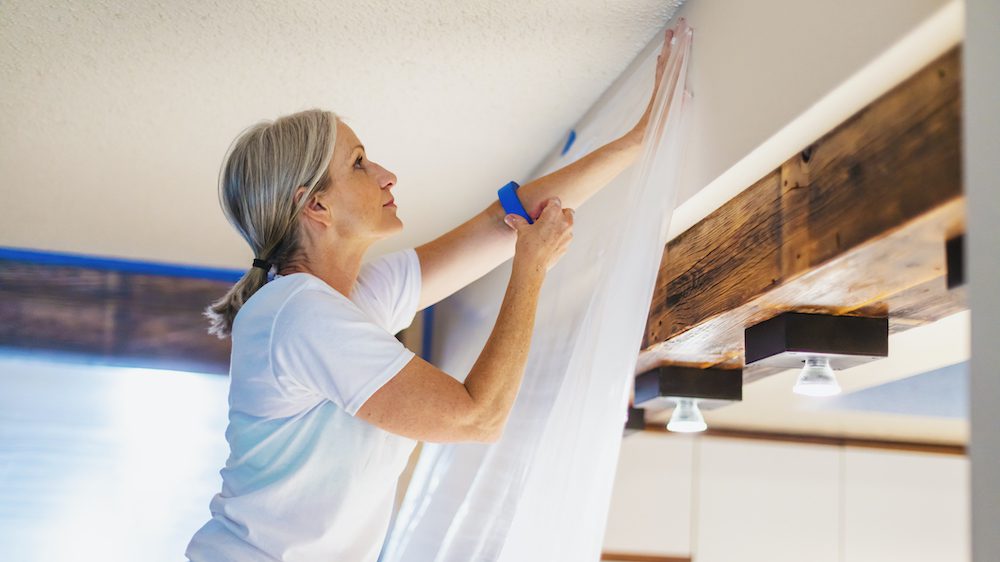
Getty Images
Deciding to have our house painted was a big decision, but once we made it, we couldn’t wait to see the final results. But wait we did.
What we hadn’t anticipated was all the prep work that went into getting our house ready for painting. There was power washing to be done, windows to be caulked, vines to be removed, and a host of other tasks that took weeks to complete before we finally saw that oh-so-carefully chosen shade of white paint start to cover up the mustard yellow we’d lived with for far too long.
While each paint job is different and requires varying preparations (we had roof repairs and other bigger issues), there are some basic things that must be done before any home painting begins.
Rick Watson, director of product information at Sherwin-Williams, says far too many people skip painting preparation or do it improperly.
“About 80% of all coating failure is due to improper preparation,” he says.
The goal is the same, whether painting indoors or out: to create a clean, dry, smooth, and structurally sound surface before the paint is applied. Even if you hire professionals to do the painting, doing some of the prep work yourself can save money and make sure the results are as perfect as you’d hope.
“It’s easy to rush and forget to clean or prep your painting surface beforehand,” agrees Jessica Barr, a paint application expert for Behr Paint Co. “To avoid wasting time or duplicating efforts, it’s worth going the extra mile to ensure your workspace is fully prepared and ready to go.”
Here’s how to make sure you get the most out of your paint.
1. Clean before you paint
Inside: Use a duster to get rid of surface dust and remove any cobwebs. Then wipe down the surface using a rag or washcloth dampened in a mixture of mild detergent and warm water to remove lingering dirt and debris.
Outside: Power washing is usually the most efficient and effective way to clean your home’s exterior walls. To get rid of mildew and keep it from coming back, Lowe’s suggests using a detergent that contains mildew remover or making your own solution by combining a quart of bleach with three quarts of water.
2. Do repairs before you paint
Inside: Inspect your walls for any cracks or holes. Patch as necessary, then sand until the surface is smooth. And as counterintuitive as it may seem, sanding should happen after cleaning the surface. Watson says sanding before cleaning can grind in the general contaminants that may be sitting on that surface.
“Grease, dirt, and grime that has built up over time will be pushed deeper into the existing finish or grooves/scratches you made by sanding,” he says. “Once painted, those contaminants may leach back out through the paint film, causing adhesion and peeling issues, blotchiness and stain bleed through your finish. It’s important to always clean the surface first prior to sanding or wire brushing.”
Outside: If your walls have chipped and peeling paint, scrape it off with a wire brush, then sand. The same goes if you have crawling vines or other foliage covering the walls you want to paint.
Attend to any areas that need to be patched, repaired, or recaulked. Make sure to use products that are designed for outdoor use. Depending on what shape your house is in as well as the tools you have at your disposal, the repairs and cleaning may be best done by professionals.
3. Protect your property before you paint
Inside: Sure, you don’t plan to drip paint on the carpet or your couch, but it happens. Remove any rugs and furniture that you can, then put down dropcloths or otherwise cover the flooring and furniture in the room you’re painting.
Outside: Move any outdoor furniture, and use dropcloths to protect your grass, plants, flowers, and other items that can’t be moved out of the way. For plants close to the walls, you may need to tie them up to allow room for painting.
4. Tape before you paint
Inside: For professional-looking results, tape off all the surfaces you don’t want painted (e.g., windows, floorboards, and ceilings). Not just any tape will do though; you need painter’s tape, which is specially made for the job and won’t leave residue behind. Make sure it’s applied straight and flat to avoid paint seeping under it. Running a knife over it may help.
Outside: Painter’s tape designed for exterior surfaces is available to section off areas you don’t want to paint.
Once you decide to paint an area of your home, it’s easy to get caught up in the excitement and want to rush home with paint and get the transformation started, stat. As tempting as it may be to skip some of these steps though, a bit of patience and preparation will pay big-time off in the end.
The post Paint Prep, Explained: 4 Things You Absolutely Must Do Before Painting Your House appeared first on Real Estate News & Insights | realtor.com®.
No comments:
Post a Comment